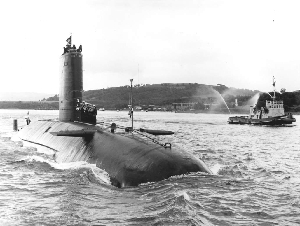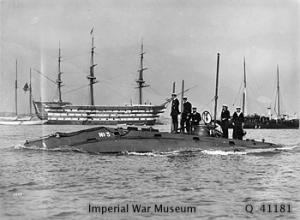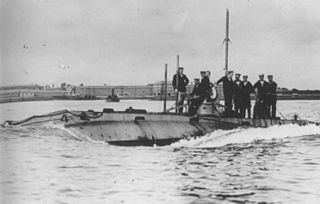
HMS Astute is an operational nuclear-powered attack submarine in the Royal Navy, the lead boat of her class.

HMS Conqueror was a British Churchill-class nuclear-powered fleet submarine which served in the Royal Navy from 1971 to 1990. She was the third submarine of her class, following the earlier Churchill and Courageous, that were all designed to face the Soviet threat at sea. She was built by Cammell Laird at Birkenhead.

HMS A1 was the Royal Navy's first British-designed submarine, and their first to suffer fatal casualties.

HMS A3 was an A-class submarine built for the Royal Navy in the first decade of the 20th century. She sank in 1912. The wreck is a Protected Wreck managed by Historic England.
HMS A5 was an early Royal Navy submarine. She was a member of Group Two of the first British A class of submarines. Like all members of her class, she was built at Vickers Barrow-in-Furness.
HMS Western Isles was a command ship of the Royal Navy during World War II, serving as the flagship of the Anti-Submarine Training School at Tobermory on the Isle of Mull under Vice Admiral Gilbert Stephenson. Launched in 1902 as the Dutch Batavier Line passenger ship Batavier IV, after the war she served in the Royal Netherlands Navy as the training ship Hr. Ms. Zeearend. She was decommissioned in 1970, and scrapped in 1972.

HMS Hawke, launched in 1891, was the seventh British warship to be named Hawke. She was an Edgar-class protected cruiser.

Holland 1 is the first submarine commissioned by the Royal Navy. The first in a six-boat batch of the Holland-class submarine, she was lost in 1913 while under tow to be scrapped following her decommissioning. Recovered in 1982, she was put on display at the Royal Navy Submarine Museum, Gosport. Her battery bank found in the boat was discovered to be functional after being cleaned and recharged.

HMS Holland 2 was the second Royal Navy submarine to be built, and the first to be given a non-secret launch, in February 1902.

The Royal Navy Submarine Service is one of the five fighting arms of the Royal Navy. It is sometimes known as the Silent Service, as submarines are generally required to operate undetected.

Holland 5 was the last of the five Holland-class submarines ordered by the British Admiralty to evaluate the potential of the submarine with the Royal Navy. She was one of the first submarines to be accepted into Royal Navy service, and unique to her class, she carried one of the earliest periscopes. By the time she was launched, a number of A-class submarines had already been ordered to replace this class in navy service.

Holland-class submarine No 4 was built by Vickers, at Barrow in Furness, Cumbria, United Kingdom, and was laid down in 1902. She was launched on 23 May 1902, and successfully concluded deep sea trials in the Irish Sea in August 1902. She was commissioned into the Royal Navy on 2 August 1903. In 1905 the submarine was fitted with a conning tower. She was the only member of the Holland-class to be given this modification. She was stricken in 1912. She foundered on 3 September 1912. She was salvaged and used as a gunnery target on 17 October 1914.

HMS Audacious is the fourth Astute-class nuclear-powered fleet submarine of the Royal Navy. Several previous vessels of the Royal Navy have borne the name. She was formally named on 16 December 2016 and was launched on 28 April 2017. Audacious was stated to be handed over in January 2021. A parliamentary written answer stated that Audacious was commissioned on 3 April 2020, but her public ceremonial commissioning took place on 23 September 2021.
HMS H51 was a British H class submarine built by HM Dockyard, Pembroke Dock. She was laid down on an unknown date, launched on 15 November 1918 and commissioned into the British Royal Navy on 1 September 1919. It had a complement of twenty-two crew members.

HMS H49 was a British H-class submarine built by William Beardmore and Company, Dalmuir. She was launched on 15 July 1919 and commissioned on 25 October 1919.

HMS H21 was a British H class submarine built by Vickers Limited, Barrow-in-Furness, as the first of the Batch 3 H class submarines. She was launched on 20 October 1917 and was commissioned on 28 January 1918. H21 was an improved design of the H class which produced a larger displacement and the latest 21 inch torpedo tubes replacing the old 18 inch torpedo tubes. This would be incorporated into all batch 3 H class submarines. HMS H21 was sold to John Cashmore Ltd on 13 July 1926 for scrapping at Newport.
HMS H23 was a British H class submarine built by Vickers Limited, Barrow-in-Furness as part of the Batch-3 H class submarine. She was launched on 29 January 1918 and was commissioned on 25 May 1918. She had a complement of 22 crew members.
HMS E47 was an E-class submarine launched by Fairfield, Govan for the Royal Navy and completed by William Beardmore, Dalmuir. She was launched on 29 May 1916 and was commissioned in October 1916.
HMS Star was a Palmer three-funnel, 30-knot destroyer ordered by the Royal Navy under the 1896–1897 Naval Estimates. She was the eleventh ship to carry this name since it was introduced in 1643 for a 19-gun ship sold until 1652.

HMS Delphinium (K77) was a Flower-class corvette built for the Royal Navy (RN) from 1940-1946. From 1941 to 1943 she was active in the Mediterranean as an escort to convoys supporting the Eighth Army and the invasion of Sicily. From mid-1943 onwards she was on convoy escort duties between Africa, the Mediterranean and the United Kingdom; and Atlantic convoys between North America and the United Kingdom. She escorted a total of 68 convoys.














